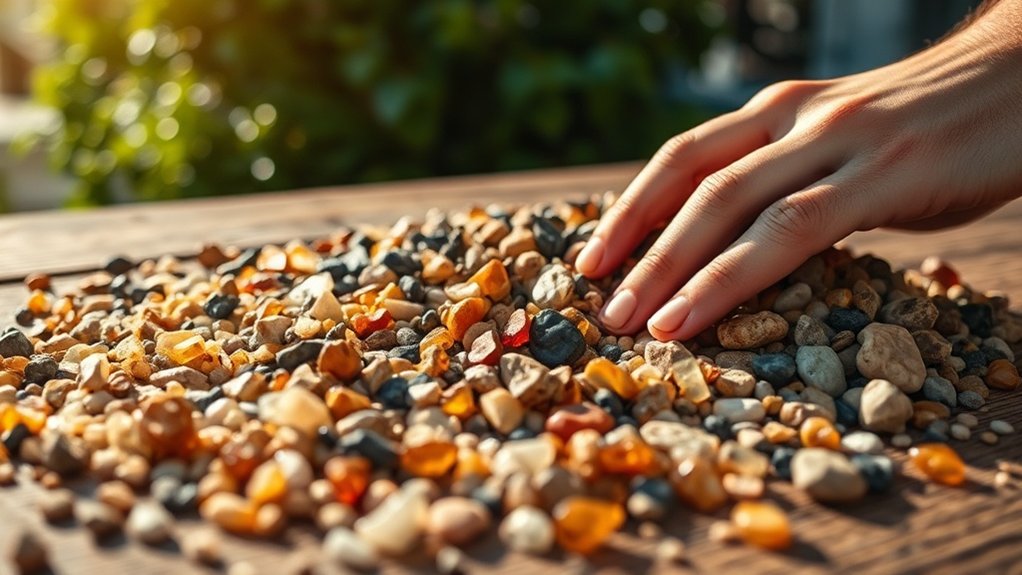When selecting the best aggregate for your resin-bound patio, focus on quality, size, and grading. Choose clean, kiln-dried aggregates to promote strong resin bonding. Opt for angular shapes as they provide better traction and drainage, which is important for meeting SuDS standards.
Consider the colour stability of the aggregates for visual appeal, and feel free to mix natural and synthetic options for a unique look. Ensure the aggregates are durable and have the right porosity. Also, check local suppliers, as this can influence both cost and availability. By keeping these factors in mind, you can enhance both the performance and appearance of your patio.
Key Takeaways
- Opt for aggregates that are washed and kiln-dried to ensure strong resin bonding and increased durability for your patio.
- Select the appropriate size and grading of aggregates to maximise the surface area for bonding and improve water drainage, in line with SuDS regulations.
- Consider both natural and synthetic aggregates for visual appeal, striking a balance between rustic aesthetics and vibrant colours with consistent finishes.
- Assess local suppliers for cost-effectiveness and ensure the aggregates meet durability standards, such as passing abrasion tests and exhibiting low wash loss.
- Choose aggregates with a void ratio of 30-32% to enhance water retention, which will improve the patio’s performance across different weather conditions.
Understanding Aggregate Types
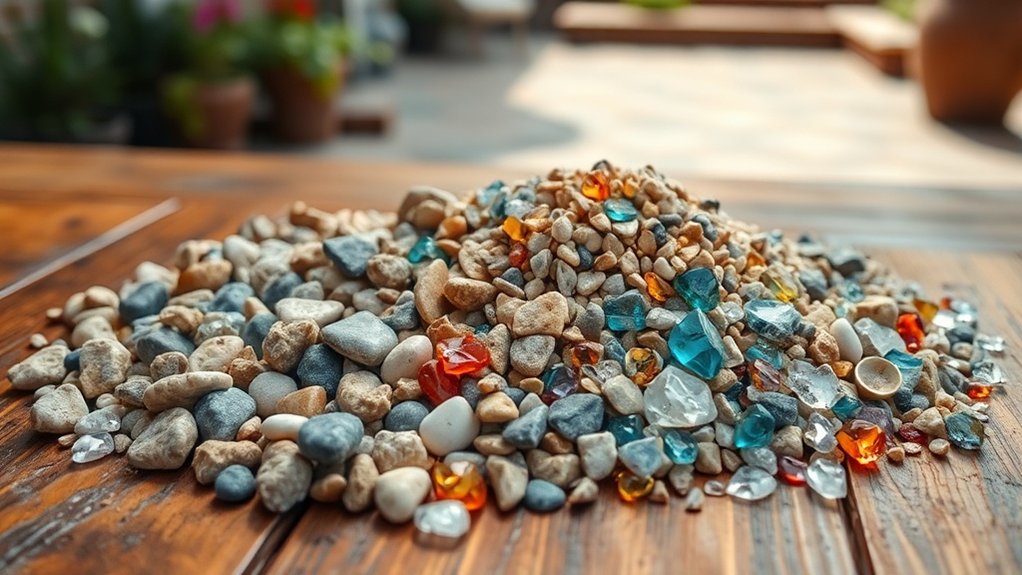
When selecting aggregates for a resin-bound patio, it’s important to understand the different types available. The choice of aggregate can significantly influence both the look and functionality of your patio.
You can opt for natural aggregates for a classic appearance or choose recycled options for an eco-friendly alternative. Crushed glass can improve slip resistance, while marble and stone aggregates add a touch of luxury. Ensure the aggregates are washed and kiln-dried; this enhances their performance by ensuring a strong bond with the resin. Additionally, check that they’re compatible with polyurethane resin for better durability. Using carefully washed aggregates will ensure that dust and moisture are removed, preventing potential failure when mixed with the resin. The use of washed, kiln-dried stones is vital for optimal bonding and reducing maintenance issues associated with resin-bound projects.
Choosing the right aggregate will help you create a patio that looks fantastic and meets your performance and environmental requirements.
Importance of Aggregate Size and Grading
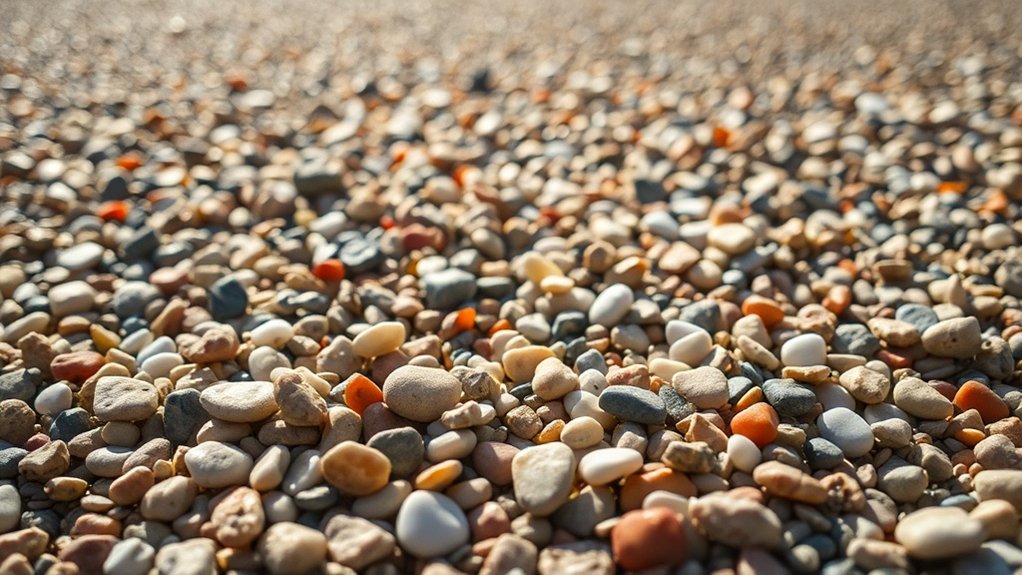
Choosing the right type of aggregate is just the starting point; understanding aggregate size and grading is crucial for a durable and attractive resin-bound patio. The size and grading of aggregates significantly affect performance and sustainability. For instance, larger aggregates can lead to reduced resin coverage, weakening the bond, while finer aggregates may absorb too much resin, compromising strength. Precise grading optimises surface area for better resin bonding, enhancing durability and reducing the risk of cracking. Additionally, proper grading of aggregates allows for improved water drainage, which is essential for effective water drainage and compliance with Sustainable Urban Drainage Systems (SuDS). Well-graded, angular aggregates also ensure good permeability, which is essential for effective water drainage and compliance with Sustainable Urban Drainage Systems (SuDS). Additionally, using compacted type 1 aggregate provides an excellent load-bearing capacity, ensuring the patio can withstand heavy foot traffic over time.
Exploring Aggregate Colour and Aesthetics
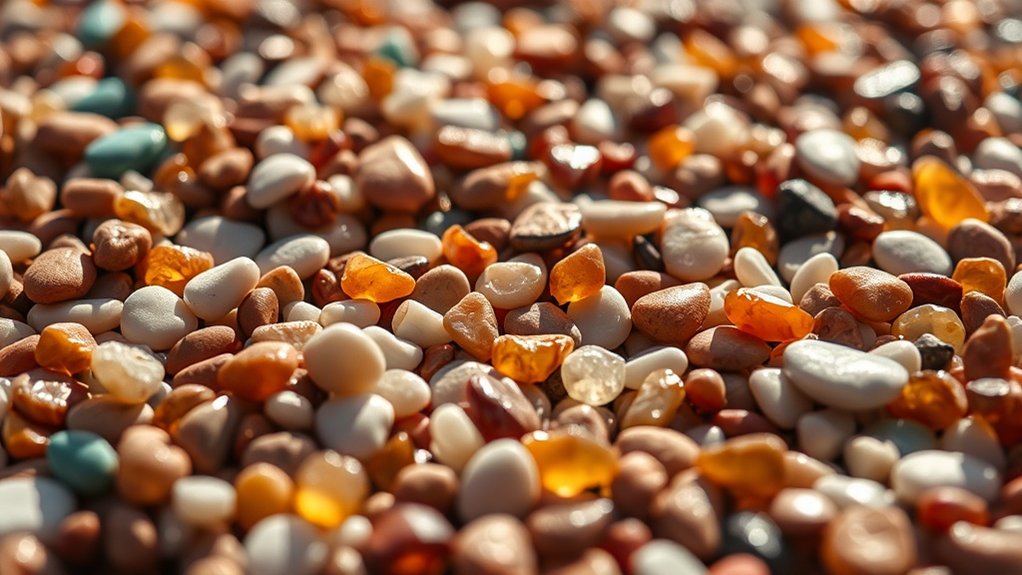
When choosing aggregate colour for your resin-bound patio, it’s important to consider different techniques to achieve the look you want. You can opt for natural or synthetic aggregates, each offering unique visual effects and maintenance requirements. It’s also crucial to check the UV stability of the colours to ensure they remain vibrant over time, especially in areas that get plenty of sunlight. For example, lighter colours may fade faster under direct sunlight. One popular option among homeowners is Harvest Gold, which provides a warm golden brown blend that is ideal for creating inviting walkways and patios. Additionally, exploring custom color mixing allows you to match existing property features for a more personalized design.
Colour Selection Techniques
Choosing the right aggregate colour for your resin-bound patio may appear simple, but it plays a crucial role in the overall look and feel of your outdoor space. Consider colour psychology and seasonal trends when picking your shades. For instance, warm tones like Harvest Gold and Sienna bring a summery feel, while earthy colours such as Cappuccino reflect the essence of autumn. You can either blend with your surroundings or opt for contrasting colours to create visual interest.
| Colour Type | Examples | Effects |
|---|---|---|
| Warm Hues | Harvest Gold, Sienna | Inviting atmosphere |
| Cool Tones | Silver Cloud | Modern elegance |
| Nature-Inspired | Cappuccino | Natural integration |
Natural vs. Synthetic Options
When choosing aggregates for your resin-bound patio, it’s important to weigh the benefits of natural versus synthetic options.
- Natural aggregates, such as granite and quartz, offer earthy tones and a rustic look that perfectly complements garden settings.
- Synthetic aggregates provide a range of vibrant colours and a consistent finish, giving you more design flexibility.
- Mixing both types can produce striking contrasts in texture and colour, tailored to your personal style.
- Don’t forget to consider how texture affects light reflection, as this can alter the overall appearance under different lighting.
Your choice between natural and synthetic aggregates will significantly influence your patio’s aesthetics and its long-term appeal.
UV Stability Considerations
Understanding UV stability is crucial for keeping the colour and appearance of your resin-bound patio intact. The aggregates you choose play a significant role in this. Opting for UV-stable resins, such as aliphatic polyurethane, ensures the durability of the aggregates and prevents issues like yellowing or discolouration.
Light-coloured aggregates reflect sunlight, which helps reduce heat absorption and fading, while darker aggregates can put more stress on the resin over time. By pairing vibrant aggregates with high-quality, UV-stable resins, you can maintain the aesthetic appeal of your patio.
It’s also important to get the resin-to-aggregate ratio right for optimal UV resistance, ensuring long-lasting colour and less need for maintenance.
In short, choosing the right materials will help you create a visually appealing and durable patio that stands the test of time.
Ensuring Quality and Proper Processing
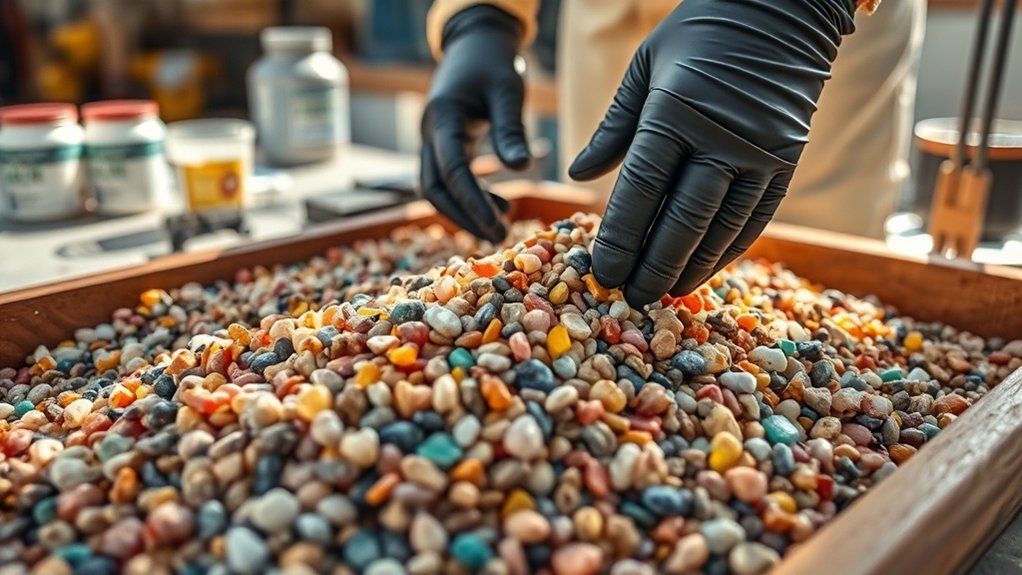
To ensure a high-quality resin-bound patio, it’s crucial to pay attention to the cleanliness, dryness, and grading of the aggregates used. Proper quality control during the sourcing of aggregates will lead to better performance and durability.
Here are some key points to consider:
- Cleanliness: Make sure to thoroughly clean aggregates to remove any dirt, as this can weaken the bond with the resin.
- Dryness: Check that aggregates are completely dry; moisture can compromise bonding and reduce durability.
- Dust-Free Condition: Screen aggregates to eliminate dust particles, which can result in a cloudy finish and hinder adhesion.
- Proper Grading: Ensure aggregates are graded for uniform size; this not only affects the strength and appearance but also improves drainage.
Assessing Suitability for Different Uses
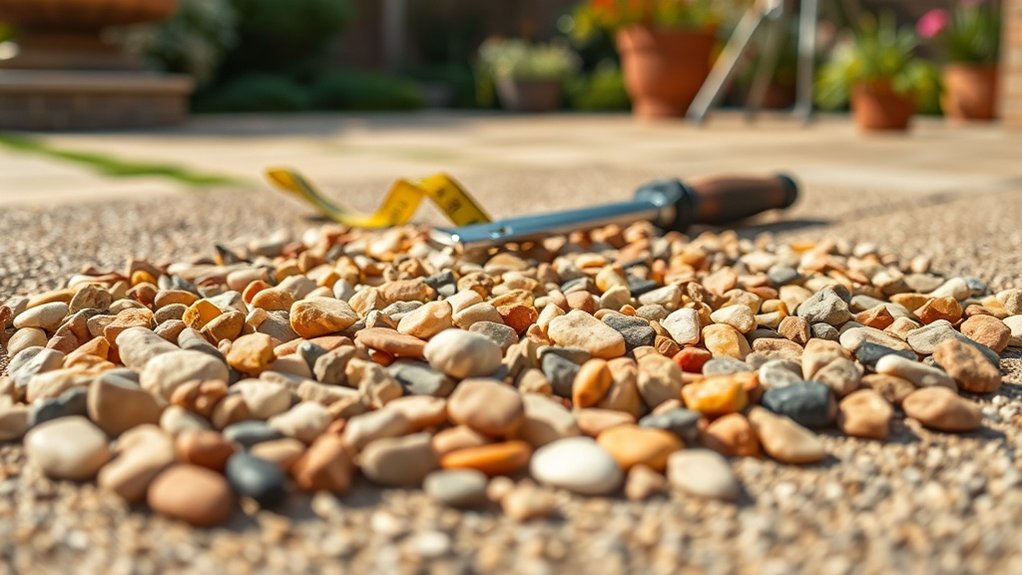
When assessing aggregates for your resin-bound patio, consider the expected traffic.
For high-traffic areas, opt for aggregates that provide better durability and slip resistance. In contrast, lighter-use spaces can incorporate smaller, more visually appealing options.
Also, take into account local weather conditions and drainage requirements, as these factors are crucial for the patio’s durability and effectiveness.
Traffic Type Considerations
Choosing the right aggregate for a resin-bound patio depends on the types of traffic the surface will experience. Here are key factors to consider:
- Traffic Load: Opt for denser aggregates if you expect heavy use, such as from vehicles or large gatherings.
- Vehicle Suitability: Ensure the surface has a texture that provides good traction and is smooth enough to minimise wear on tyres.
- Pedestrian Safety: Use aggregates with slip-resistant properties to keep foot traffic safe, especially in wet conditions.
- Cycle Path Considerations: Select textured surfaces to enhance grip and ensure proper drainage to avoid water pooling.
If you’re planning for special events, consider the load capacity and whether additional protective layers are needed to preserve the surface.
Environmental Conditions Impact
Understanding how environmental conditions affect the performance and lifespan of a resin-bound patio is crucial for ensuring its suitability for various uses.
Resin-bound systems are highly resilient to climate, effectively managing stormwater through their permeable design, which helps reduce local flooding. They can withstand freeze-thaw cycles without losing structural integrity, making them suitable for colder climates.
Using light-coloured aggregates can help combat the Urban Heat Island effect by reflecting solar radiation and lowering surface temperatures.
Moreover, incorporating recycled materials enhances sustainability, while the seamless surface requires minimal maintenance.
Evaluating Cost and Availability
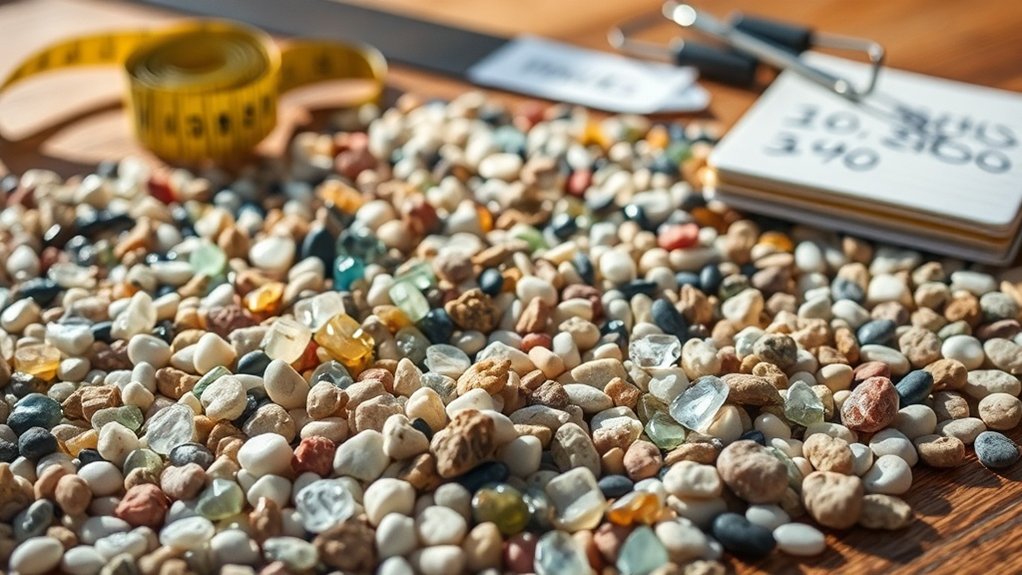
Evaluating the cost and availability of aggregates for a resin-bound patio is crucial for budget-savvy homeowners.
Keep these factors in mind to manage expenses effectively:
- Aggregate sourcing: Opt for local suppliers to cut down on transport costs.
- Material quality: While higher-quality aggregates might increase initial costs, they can improve durability and appearance, making them a worthwhile investment.
- Project size and complexity: Expect larger or more detailed designs to raise both material and labour costs.
- Regional variability: Prices can vary significantly based on local supply and demand, so be sure to check local quotes.
The Role of Aggregate in Surface Durability
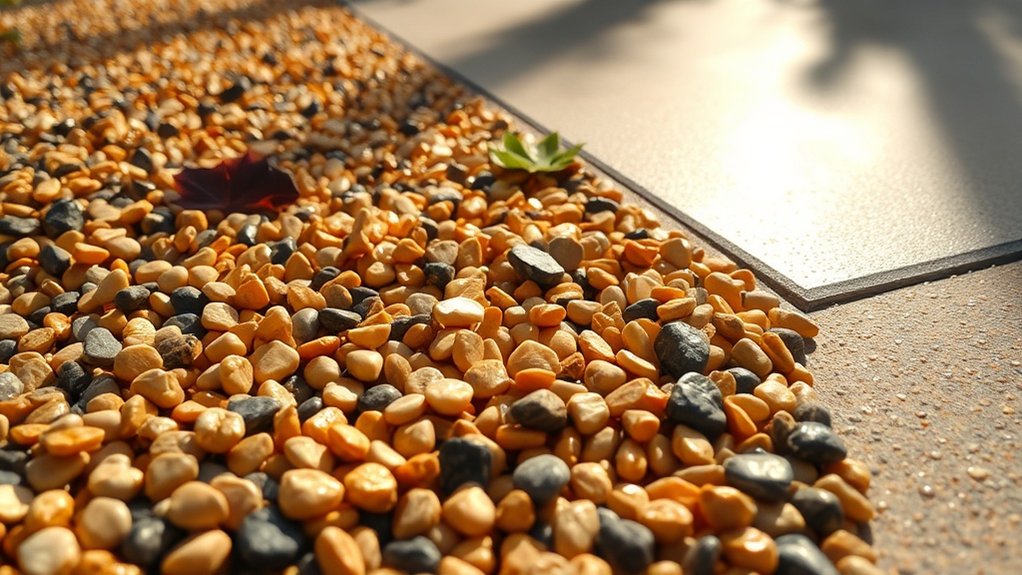
The durability of a resin-bound patio largely depends on the type and quality of aggregates used. Choosing the right aggregate significantly impacts performance and longevity.
For instance, high-quality aggregates like granite or quartz can provide excellent surface strength, while smaller stones tend to wear better and distribute loads more evenly.
It’s essential to ensure that aggregates are clean and free from dust, as this promotes better bonding with the resin.
The size and gradation of the aggregates also play vital roles in resisting wear and tear.
Impact of Aggregate on Slip Resistance
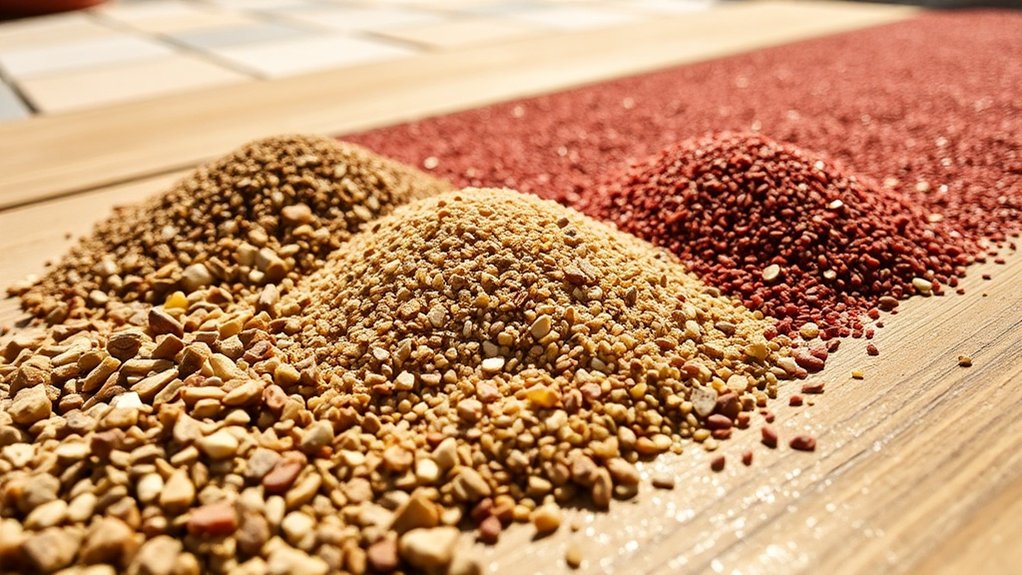
Slip resistance is essential for the performance of a resin-bound patio, and the choice of aggregate is crucial for ensuring safety. The texture and shape of aggregates directly impact slip resistance, making your patio safer in various conditions.
Here are some key points to consider:
- Angular aggregates provide better grip thanks to their rough surfaces.
- Highly angular aggregates fit together well, reducing the risk of slipping.
- The texture of the aggregates is linked to improved skid resistance.
- Proper gradation increases the contact area, enhancing traction.
Choosing the right aggregate can make a significant difference in the safety of your outdoor space.
Choosing the Right Aggregate for Permeability
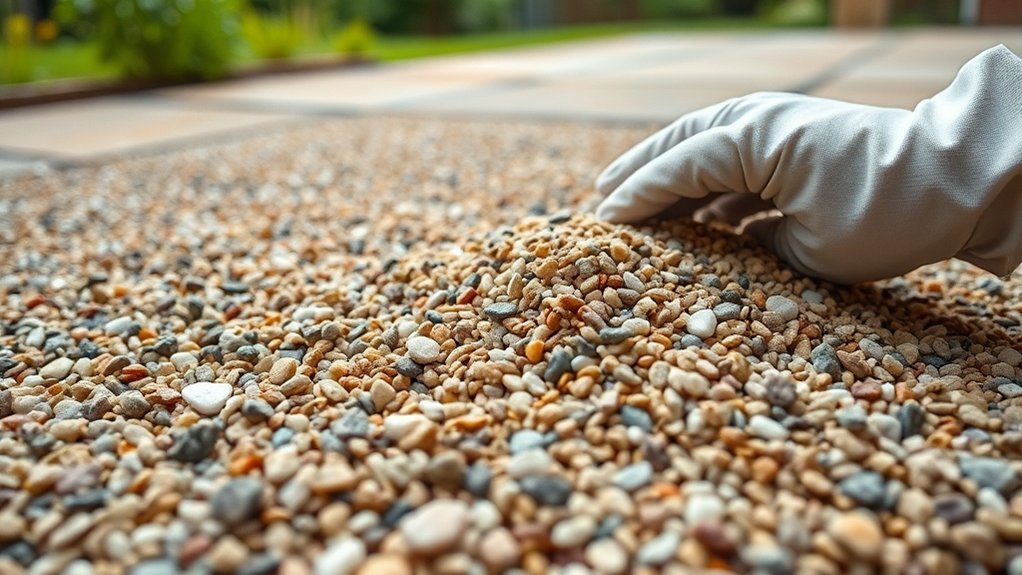
When choosing aggregates for permeability in a resin-bound patio, opt for open-graded aggregates that allow water to flow freely and minimise clogging.
The size of the aggregates is crucial; larger particles create gaps that improve drainage, while a combination of sizes can enhance both permeability and surface stability.
Also, ensure your aggregate selection meets SUDS standards to support effective stormwater management.
Open-Graded Aggregate Selection
Selecting the right open-graded aggregate is crucial for achieving optimal permeability in resin-bound patios.
Here are key factors to consider:
- Gradation Type: Opt for higher permeability gradations, such as Gradation A, to improve water flow.
- Fines Content: Keep fines to a minimum to ensure interconnected pore networks; excessive fines can significantly hinder permeability.
- Mineralogy: Limestone aggregates generally provide better permeability than sandstone or chert.
- Construction Quality: Ensure proper layering during installation and prevent fines from mixing in to maintain the intended permeability.
Aggregate Size Importance
Aggregate size is crucial for the permeability of a resin-bound patio. Smaller aggregates create fewer voids, which reduces permeability, while larger aggregates (6-10mm) increase voids, allowing more water to pass through.
For optimal performance, it’s advisable to use a combination of aggregate sizes, such as 1-3mm with 2-5mm. This mix strikes a balance between permeability and a smooth surface.
Choosing the right aggregate size not only facilitates water drainage but also ensures the patio remains structurally sound, preventing issues like surface clogging over time.
Opting for the wrong size can lead to reduced functionality and higher maintenance. Understanding the impact of aggregate size on permeability is key to enhancing your patio’s durability and performance.
Compliance With Suds Standards
Ensuring compliance with SuDS standards is vital for managing runoff in resin-bound patios.
To meet these standards, consider the following when selecting your aggregates:
- Choose aggregates with a void ratio of 30-32% for proper water retention.
- Use durable materials, such as coarse graded crushed rock or gravel, that can withstand the elements.
- Make sure the aggregates have a porosity of 0.4 and minimal wash loss.
- Check that the aggregates pass abrasion tests to guarantee their durability.
Tips for Testing Aggregate Samples
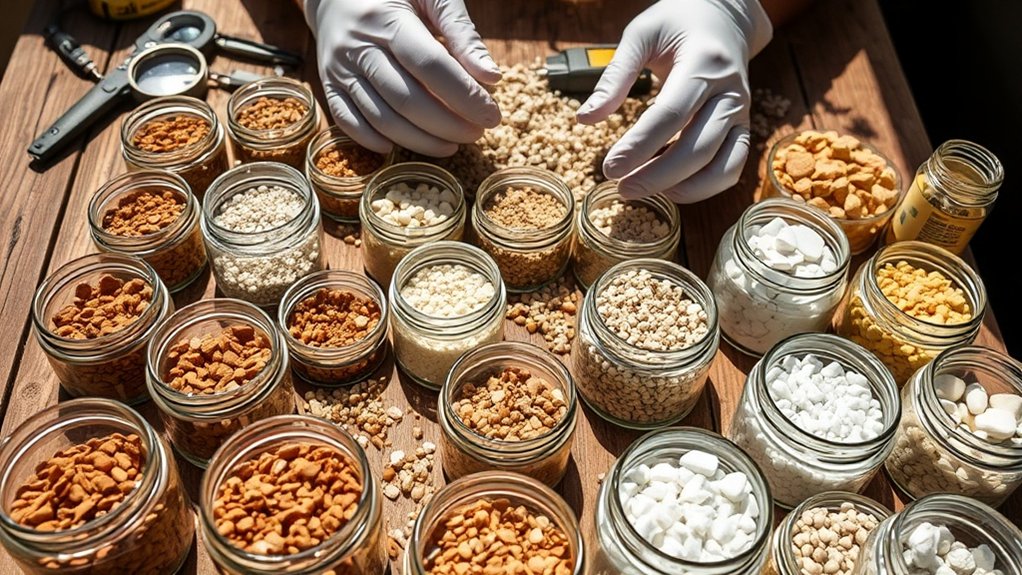
To effectively assess aggregate samples for a resin-bound patio, start with reliable testing methods to measure moisture content. Aim for moisture levels below 0.5%, as excess moisture can dilute the resin, weakening the bond and reducing durability. Use moisture meters or the oven-dry test on-site, considering variable conditions.
Next, check the particle size and grading; aggregates should be between 1-5 mm. Angular aggregates improve mechanical interlock, while minimising excessive fines is crucial for permeability.
Conduct small-scale mixing tests to ensure resin compatibility and uniform coating. Finally, evaluate durability with tensile strength tests and freeze/thaw cycling to ensure your mix meets design specifications and can withstand environmental conditions.
Working With Reputable Suppliers
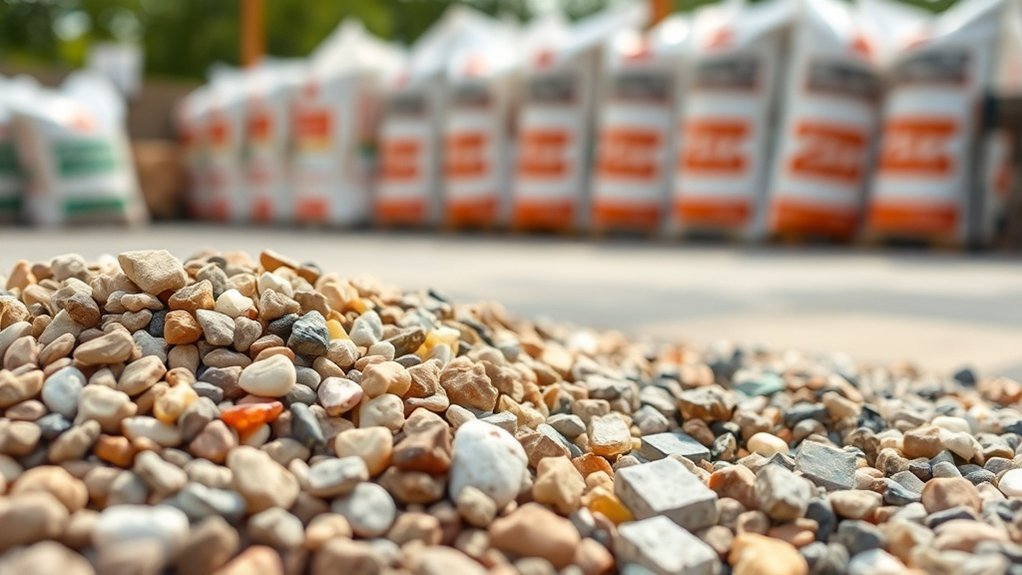
When choosing materials for your resin-bound patio, partnering with trusted suppliers is essential for ensuring quality and longevity.
Consider the following when assessing suppliers:
- Supplier Certifications: Check for industry certifications that confirm they meet recognised quality standards.
- Aggregate Sourcing: Opt for suppliers with a national distribution network to ensure consistent availability and quality of materials.
- Product Range: Select suppliers that offer a variety of kiln-dried and washed aggregates to suit your design preferences.
- Technical Support: Choose suppliers who provide comprehensive technical guidance and resources, ensuring correct installation practices.
Frequently Asked Questions
How Do I Maintain My Resin-Bound Patio Post-Installation?
To keep your resin-bound patio in top shape, make sure to sweep it weekly and wash it monthly. Check for any damage and clear away debris seasonally to maintain its appearance and longevity all year round.
Can I Mix Different Aggregates for a Unique Look?
Yes, you can mix different aggregates for a unique finish. Combining various aggregates not only improves the visual appeal but also adds functionality while ensuring drainage. Just be mindful of the ratios to maintain strength and durability in your resin-bound surface. For example, mixing smooth pebbles with sharp gravels can create an interesting texture while still being practical.
What Is the Expected Lifespan of a Resin-Bound Patio?
A resin-bound patio usually lasts between 15 and 25 years, with top-quality materials potentially extending the lifespan to 30 years. The durability of the materials used and the quality of installation play a significant role in determining how long your patio will last. Regular maintenance is key to ensuring its longevity.
Are There Eco-Friendly Aggregate Options Available?
You can choose eco-friendly aggregate options such as sustainable materials and recycled aggregates. These alternatives not only benefit the environment but also improve the durability and appearance of your resin-bound patio.
How Does Temperature Affect the Resin’s Curing Process?
Temperature significantly influences the curing time of resin. Higher temperatures speed up the process, while cooler conditions slow it down. For instance, if you’re working in a warm room, your resin will set quickly, but in a chilly garage, it may take much longer. Keeping the temperature within an ideal range ensures proper curing, avoiding problems like brittleness or uneven surfaces in your finished project.
Conclusion
When selecting the best aggregate for your resin-bound patio, consider how each choice impacts your overall vision. The size, colour, and quality of the aggregate can significantly affect both the look and function of your patio. For instance, lighter colours can brighten up small spaces, while darker shades may add sophistication.
Safety features like slip resistance and permeability are crucial, especially in wet conditions. To ensure you make the right choice, test samples from different suppliers and consult with reputable sources. This process is more than just picking materials; it’s about creating a patio that blends style with practicality. Remember, every detail counts in making your patio a true reflection of your taste.
